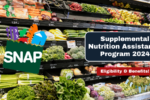Free Food Programs for U.S. Citizens : Food insecurity affects millions of Americans, leading to unreliable access to nutritious food. Fortunately, the U.S. government offers several programs to address this issue and ensure that individuals and families in need can access healthy meals. Managed by the United States Department of Agriculture (USDA) and the Food and Nutrition Service (FNS), these programs are specifically designed to assist low-income households.
They provide vital support through various initiatives, including food assistance benefits and meal programs. By focusing on improving access to nutritious food, these programs play a crucial role in alleviating food insecurity and promoting better health outcomes for vulnerable populations across the country.
This article examines the various programs offering free food assistance, detailing the eligibility criteria and application process to help individuals and families access the support they need.
Table of Contents
Free Food Programs for U.S. Citizens
Here are some free food programs for U.S. citizens:
Supplemental Nutrition Assistance Program (SNAP)
SNAP, or food stamps, offers monthly benefits to help eligible households buy food at authorized retailers. The benefit amount depends on factors such as household income, size, and certain expenses. This program aims to improve food security by providing financial support for purchasing nutritious groceries.
Eligibility Criteria
| Eligibility Factor | Description |
|---|---|
| Household Income | Must be below 130% of the federal poverty level, varying by family size and location. |
| Household Size | Income limits depend on the number of people in the household. |
| Allowable Expenses | Certain expenses, such as housing costs, are considered in determining eligibility. |
| Income Limits | Limits vary by family size and geographic location. For specific figures, refer to the current federal poverty guidelines. |
| 300 Reduction In Social Security Benefits |
| Thinx Lawsuit Class Action Payment 2024 |
| Johnson And Johnson Lawsuit 2024 |
| Canada 300 Federal Payment Announced |
| Ontario Teacher Pension Plan |
Emergency Food Assistance Program (TEFAP)
TEFAP provides emergency food relief through food banks and pantries to address immediate hunger needs. This program is designed for individuals and families who face short-term food insecurity. It focuses on distributing food to those in urgent need and helping them manage temporary food crises.
Eligibility Criteria
| Eligibility Factor | Description |
|---|---|
| Income Requirement | TEFAP does not have a strict income limit but is aimed at low-income populations. |
| Food Distribution | Managed through food banks and pantries, which may set their own eligibility guidelines. |
| Target Population | Focuses on individuals and families facing immediate food insecurity or emergency situations. |
Special Supplemental Nutrition Program (WIC)
WIC offers nutritional assistance to pregnant and postpartum women, breastfeeding mothers, and young children up to age five. Participants receive vouchers for nutritious foods like fruits, vegetables, milk, and infant formula, promoting healthy diets and improving the well-being of mothers and young children.
Eligibility Criteria
| Eligibility Factor | Description |
|---|---|
| Income | Applicants typically must have an income at or below 185% of the federal poverty level. |
| Nutritional Risk | Eligibility is also based on assessing nutritional risk and the health status of applicants. |
| Target Population | Includes pregnant women, breastfeeding mothers, new mothers, and children up to age five. |
School Breakfast and Lunch Programs
These programs provide free or reduced-price meals to eligible students in public and select private schools. The goal is to ensure children receive nutritious meals during the school day, supporting their health and academic performance by reducing food insecurity among students.
Eligibility Criteria
| Eligibility Factor | Description |
|---|---|
| Household Income | Eligibility is primarily based on household income levels. |
| Application Process | Schools often notify families about how to apply for free or reduced-price meals. |
| Meal Provision | There are instances when all students, regardless of financial status, get free lunches. |
How to Apply For Free Food Programs for U.S. Citizens
Step 1: Determine Eligibility
Start by evaluating which food assistance program you qualify for based on your household income, size, and specific needs.
Step 2: Gather Necessary Documents
Collect essential documents such as proof of income, residency, and household size to verify your eligibility.
Step 3: Submit Application
Submit your application online, by mail, in person, or by phone. The USDA’s Food and Nutrition Service website provides guidance and resources for applying. Local social services departments can also help with the application process.
Step 4: Follow Up
After submission, there may be a processing period. Be prepared for potential follow-up requests for additional information or documentation to ensure your application proceeds smoothly.
Accessing these programs can significantly ease the burden of food insecurity, providing essential nutrition and supporting overall well-being. Understanding these resources and the application process allows eligible U.S. citizens to benefit from valuable assistance programs.
Conclusion
Food assistance programs such as SNAP, WIC, TEFAP, and school meal programs play a vital role in addressing food insecurity across the U.S. By providing essential support to low-income individuals and families, these programs help ensure access to nutritious food and improve overall well-being. Understanding eligibility requirements and the application process is crucial for accessing these benefits. Leveraging these resources can significantly ease financial burdens and contribute to healthier, more stable lives for those in need.
FAQs
What is SNAP?
SNAP (Supplemental Nutrition Assistance Program) provides monthly benefits to help households purchase food. The size and income of the family determine how much help is provided.
How can I apply for WIC?
You can apply for WIC through local WIC agencies or online via the USDA’s website.
What does TEFAP provide?
TEFAP (The Emergency Food Assistance Program) distributes emergency food through a network of food banks and pantries.
Are school meals free for all students?
Some schools provide free meals to all students, while others require an application based on income eligibility.
What documents are needed to apply for these programs?
Generally, you will need to provide proof of income, residency, and household size.






